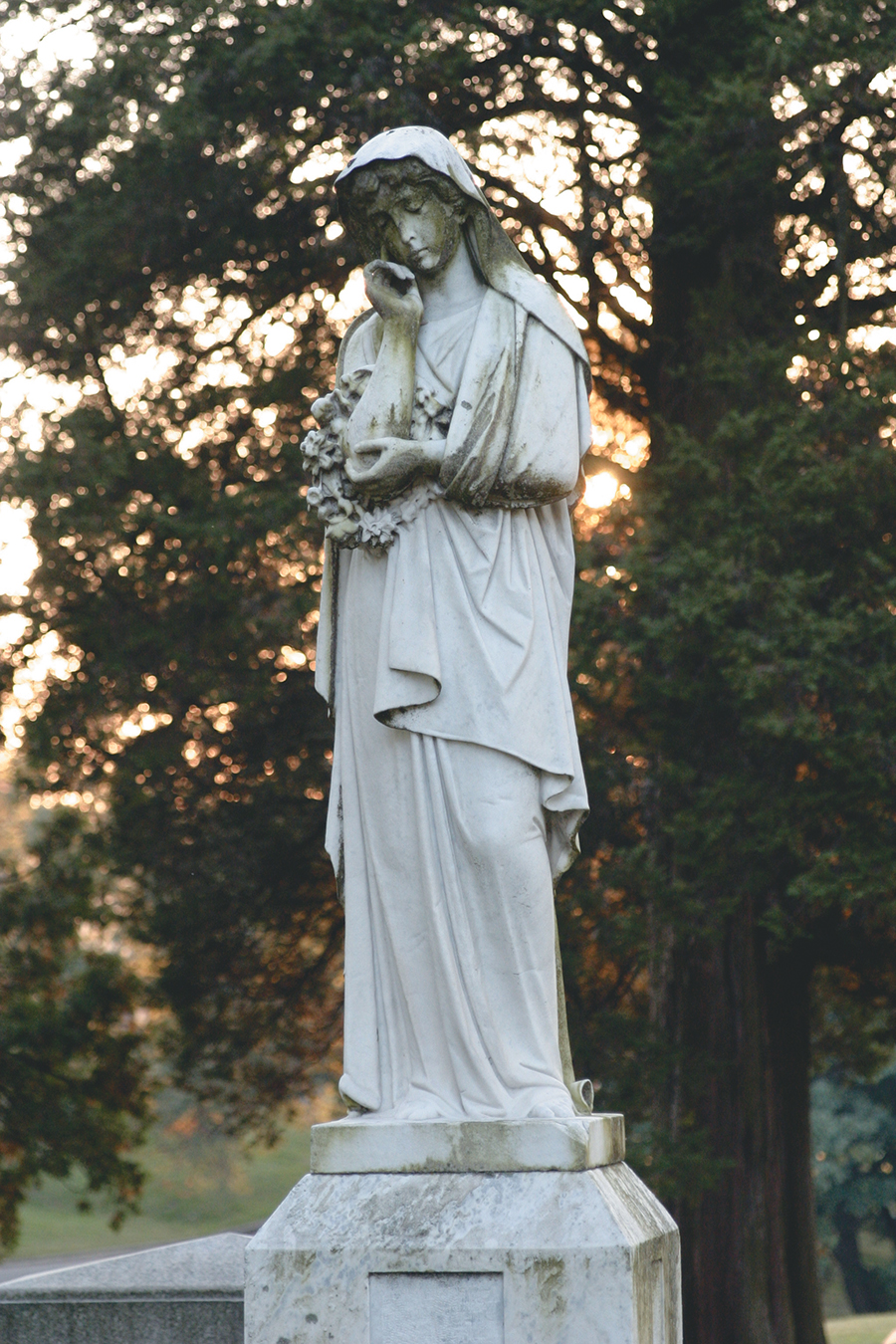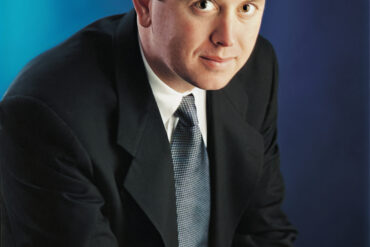From veterans of war to prominent local families, scenic Spring Hill Cemetery is rich in history and heritage.
By Joseph Platania
HQ 49 | AUTUMN 2003
As you drive up the hill from 20th Street on Norway Avenue, Spring Hill Cemetery comes into view, encompassing all of the landscape for half a mile along the right side of the road. Its dark red brick boundary wall is as familiar as any landmark in Huntington. For more than 125 years, the 110-acre cemetery has been the final resting place for thousands of residents of Huntington and the surrounding area. Spring Hill Cemetery is a historically significant state and local landmark. The cemetery also has a rich heritage that dates back to the earliest years of Huntington’s existence as a city.
With many large, old trees and peaceful, well-maintained grounds, Spring Hill is a beautiful place for a walk in any season. It is also a place to contemplate Huntington’s history with the names of many of the city’s founders and developers such as Buffington, Oley, Enslow, Emmons, Cammack, Campbell, Long, Ritter, Northcott, Switzer, Wallace, Holderby, Vinson, and Barnett etched upon prominent headstones, monuments and mausoleums.
Spring Hill is the largest Civil War cemetery in Cabell County with more than 300 Civil War soldiers, both Union and Confederate, at rest here. Billie Sue Graybeal, of Huntington, states that two of the seven Civil War generals buried in West Virginia are in Spring Hill. They are Confederate Gen. Albert Gallatin Jenkins and Union Gen. John Hunt Oley.

Veterans of the Spanish-American War (1898), both World Wars, Korea, Vietnam and Desert Storm also are buried in sections for military personnel with the designations “Soldier’s Rest,” “Soldier’s Field” and “Veterans’ Plot.”
When Spring Hill Cemetery was established by the new city of Huntington in September 1874, it was outside the city limits.
Historical accounts state that Spring Hill was first used as a cemetery during the early 1870s, but the oldest grave on the grounds is from 1838. Eldora McCoy, office manager at Spring Hill’s sales office, says that she believes from its location in the cemetery the 1838 marker is an original gravesite.
McCoy explains that the oldest grave is that of Elizabeth Prosser. She noted that in 1994, cemetery workers did a “talc-rubbing” of the concrete marker at the grave while the inscription was still visible. It reads: “Elizabeth Prosser, wife of John” and the date of her death is shown as “August 5, 1838, age 71 years and 5 months.” McCoy said that prior to the establishment of the cemetery, most of the land was open countryside. She adds that the first official burial at Spring Hill was that of Josephine Webb in 1873.

Both Spring Hill and Highland Cemetery, which is located on Saltwell Road in the city’s southeast section, are owned and operated by the Greater Huntington Park and Recreation District.
There are Civil War soldiers buried in Spring Hill Cemetery in either the GAR (Union) or the UCV (Confederate) plots, which are on a side road near the sales office. There also are many other Civil War veterans who are buried in the cemetery in addition to those interred in these two plots. One such veteran is E. A. Bennett, who was an early mayor of Huntington and a Union soldier. According to John Lavery, a local Civil War historian who is now deceased, many of Huntington’s early city councils were almost evenly divided between Union and Confederate veterans.
Civil War soldiers who are not buried in either the Union or Confederate plots often are identified by a special marker at their grave.
Based on research, 12 of the 25 Confederate soldiers in the UCV plot were either killed in action or died of their wounds during the Civil War. This number includes Gen. Albert Gallatin Jenkins, who died of his wounds on May 21, 1864 and is buried near the UCV plot. According to research, two Confederate soldiers buried in Spring Hill were killed in action on November 9, 1861. This date coincides with the Battle of Guyandotte, which took place on November 10, 1861.
At the time it was established, Spring Hill was the only integrated cemetery in the Huntington area with a section where many African-Americans are buried. Members of Huntington’s prominent African-American families, such as the Barnetts, and Revella Hughes, who was a Broadway singer and later a music teacher at the former Douglass High School in Huntington, are buried in Spring Hill.

Huntington’s first cab driver Dan Hill, who in the 1890s used a horse-drawn, four-wheel wagon to transport people around town, is buried in this section as is R.E.L. Washington, Huntington’s first black architect. Dr. Clinton C. Barnett, son of Rev. Nelson Barnett who founded the First Baptist Church in Huntington, is buried in this section as well. Dr. Barnett established the former Barnett Hospital and, later, was superintendent of the State Hospital for Colored Women at Lakin, West Virginia.
According to cemetery records, Robert T. Oney, the brave cashier at the Bank of Huntington who was robbed at gunpoint by Frank James and Cole Younger in the famous robbery of September 5, 1875, is buried in Spring Hill. Oney died 1888.
The price of a single grave space in 1874 was $1.60. In September 1954 the price was $60. Today the price ranges from $695 to $1,595.
Spring Hill increased its acreage during the early years of the 20th century and just after World War I. The cemetery also increased its size in the 1920s and 30s and as recently as the early 1970s.
Headlines of a story in The Herald-Dispatch on March 11, 1917 state: “Cemetery population larger than Huntington’s in 1900.” The article reports that “more people in the City of the Dead, Spring Hill, than lived in the corporate limits of Huntington 17 years ago (1900).”
A newspaper story in 1918 states that there were more persons buried in Spring Hill that year than in other similar periods. Death records for this time show that there were more than 1,000 interment on the hillside back of the city. This death count probably was attributed to an outbreak of the worldwide Spanish flu epidemic which hit Huntington in 1918.

A May 1939 article reports that the construction of the “brick boundary wall along Norway Avenue and elsewhere around the cemetery” began the preceding year. It adds that “management of both cemeteries (Spring Hill and Highland) has been under the control of the park commission since 1925.”
McCoy says that there are approximately 80,000 persons buried in Spring Hill Cemetery, and there are between 12,000 and 15,000 buried in Highland, a 15-acre cemetery that was established by the city of Huntington in 1892.
McCoy explains that there are at least 15 undeveloped acres at Spring Hill and since 800 persons can be buried in an acre, the cemetery will be in business far into the future.
Spring Hill originally was 30 acres in size and now it is more than 110 acres.
McCoy stated that, “In 1874, the City of Huntington purchased Spring Hill Cemetery from the Central Land Co. owned by Collis P. Huntington. The name is thought to have come from an old spring house that once stood close to where the first bodies were interred.”

During the cemetery’s early years, bodies sometimes were disinterred from private or family graveyards in Huntington and reburied in Spring Hill.
In the 1935 book Cabell County Annals and Families, local historian George S. Wallace writes, “an old Huntington graveyard on Staunton Road was divided into town lots, the graves were disinterred and moved to Spring Hill.” He notes that a number of old grave markers were destroyed including names such as Buffington, Scale, Russell and other pioneers.
The Greater Huntington Park and Recreation District (GHPRD) also owns two historic cemeteries in Huntington. One is located on Fifth Avenue in Guyandotte, near the historic Methodist church. In this old Methodist cemetery veterans of the American Revolutionary War are buried as well as others who died during the 18th century and early 19th century.
The other historic cemetery is called “Pat’s Branch” and it is located on the former INCO (now Special Metals) property and dates back to 1836. The GHPRD maintains both graveyards and keeps them accessible, but they are closed cemeteries and no burials take place there.
The brick chapel which houses Spring Hill’s sales office originally was built as a place to hold services prior to burials.
The cemetery’s last sexton was Arden Ross, who retired in 1998. Ross lived in a large yellow house on cemetery property and was employed at Spring Hill for 25 years. He would stay at the cemetery during the week and went home to be with his family in Wayne County on weekends. Ross was the last in a long line of sextons who lived on cemetery property extending back to the beginning of Spring Hill. He was succeeded by the present Superintendent of the Cemetery who does not live on the property.

McCoy compares visiting Spring Hill with its many varied tombstones, monuments and mausoleums to “reading Huntington street sign names and local school names that reflect the city’s history.”
For example, there is the grave of Union Gen. John H. Oley, who established Huntington’s school system and is considered the father of public education in the city. The cemetery is home to the graves of Rufus Switzer, a Huntington mayor during the early 1900s who is considered the founder of Ritter Park and the city’s park system, and local historian and author George S. Wallace. There are about a dozen tall obelisks in the cemetery bearing such prominent names as Harvey, Enslow, Northcott and Neal.
Eldora explains that Spring Hill Cemetery originally was located on two hills near the present sales office and included Potter’s Field, Civil War veterans’ plots and an area known as The Point.
She states that Potter’s Field now is located in Highland Cemetery and it is for the burial of indigent persons. She adds that an average of 15 persons per year are buried there and these interments are arranged by the West Virginia Department of Health and Human Resources.
The historically Catholic section, which sits on consecrated ground where members of Huntington’s prominent Catholic families are buried, dates back to the period 1910-1920.
The Pallottine Sisters who founded, and for many years operated St. Mary’s Hospital, are buried in an area adjoining this section. The names of the 16 sisters who were the first to come to Huntington in 1924 are inscribed on a monument across from the parking area on the road. According to a map of this part of the cemetery, as of 2001, there were 79 Pallottine Sisters buried in graves on a long, grassy slope in a tract with flat markers. The earliest grave is that of Sister Mathia, who died on October 22, 1931.
There also are four sections located in different parts of Spring Hill where Jewish residents of Huntington are buried including the area called B’nai Israel, which is considered the oldest of these sections. The Frankel Mausoleum has an inscription in Hebrew etched on the front, and nearby are the Hyman and Cohen mausoleums. Many headstones in sections of the cemetery where Jewish residents are buried have the Star of David inscribed on them.
There are between 20 and 25 mausoleums at Spring Hill while there are none at Highland. The oldest mausoleum dates back to the late 1800s.
McCoy says that in recent years, and because of the expense, a family will purchase a crypt rather than have a mausoleum built. In the center part of an older section of the cemetery is the Vinson family plot where Eloise Hughes Smith, of Huntington, who was a survivor of the Titanic disaster of April 15, 1912, is buried. Eloise, who died in 1941, is buried beside her father, Congressman James Hughes, and her mother, Belle Vinson Hughes.
McCoy states that the Marshall Memorial in Spring Hill, for the 75 victims of the November 14, 1970 Marshall plane crash at Tri-State Airport, was completed sometime in 1972. It is a dignified and handsome memorial that stands on high ground in the southwestern part of the cemetery.
An article in a July 1971 issue of The Herald-Dispatch describes the memorial as “a solid granite cenotaph, nine feet high surrounded by shrubbery, trees, and two diverging granite flagstone walkways over a concrete base.”
The article adds that Spring Hill Cemetery is the burial site of several victims of the crash.
The names of the six football players whose bodies could not be identified are inscribed on the front of the memorial with the inscription, “They shall live on in the hearts of their fans and friends forever, and this memorial records their loss to the university and to the community.”
Directly below their names are six unmarked graves. The other 69 victims’ names are inscribed on the remaining sides of the memorial, and the back reads: “In lasting remembrance of the members of the Marshall University football team, coaches, and devoted fans who died in the plane crash on November 14, 1970.”
The memorial, which is located in a newer section of Spring Hill Cemetery, overlooks the city. From this site a part of the Marshall campus and the new Marshall Stadium can be seen in the distance. Near the memorial are the graves of some of the other victims of the crash.
On September. 25, 1999, there was a celebration of the 125th anniversary of Spring Hill Cemetery. Some of the events that took place included historic tours, Civil War group and grave rubbings. There also were genealogy society meetings and a picnic.
A cemetery brochure sums up the vision of the citizens who founded this now historic site: “When our forefathers contemplated a beautiful hallowed ground for burial of their future generations, they chose very well in the location of Spring Hill Cemetery. With the design and layout of the cemetery, they looked well into the future. At the rate of burials today Spring Hill will be burying well into the 21st century.”
The brochure adds: “Our grounds are also rich in nature’s friends from the smallest chipmunks to the pair of mighty hawks that frequent us daily. Whether you are here for our area’s rich heritage or just for peaceful solitude, we encourage walkers and nature lovers alike.”
Bill Waugh, director of sales for Spring Hill, said, “What sets apart Spring Hill from other cemeteries is its grave sites for Union and Confederate soldiers, and unlike most cemeteries in the Tri-State, it is locally owned and operated.”
Spring Hill describes itself as “the area’s most prestigious cemetery that abounds in heritage that spans history of our region from the earliest settlers through the Civil War era to the present.”
Any research concerning Huntington or West Virginia history would not be complete without a visit to Spring Hill Cemetery, a final resting place located in the heart of the community.





